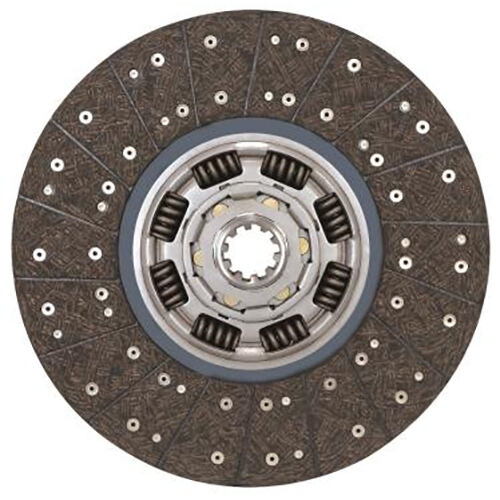Optimizing manufacturing processes demands selecting the suitable clutch pressure plate. Machinery performance and durability heavily depend on the clutch pressure plate. The following guide explains the procedure for choosing a clutch pressure plate that suits your manufacturing operations.
Fundamental knowledge about Clutch Pressure Plates must be understood first
A basic comprehension of clutch pressure plates along with their functionality becomes essential before starting with your selection process. The pressure plate operates as a vital clutch assembly part that squeezes the clutch disc for connecting or disconnecting engine power from transmission. The power transfer and machine control function becomes possible through this operation.
When applied to manufacturing operations the pressure plate's reliability and efficiency directly affects production speed as well as equipment runtime durations. Understanding its critical value helps you select the ideal component for your requirements.
Assess the Type of Machinery
Machinery selection begins with assessing the particular machine where the clutch pressure plate needs installation. Machines belonging to different categories need different technical requirements. Heavy-duty machinery that includes construction equipment along with industrial machines requires pressure plates which are built to handle intensive loads under challenging operating environments. Pressures plates have varying installation flexibility in light to medium-duty machines.
The identification of your machinery requirements such as operational parameters and environmental situations will assist you in choosing a pressure plate that fulfills the intended purpose.
Material Selection Matters
The material used in clutch pressure plates constitutes a necessary component for evaluation. The most frequently used materials for pressure plates consist of cast iron alongside steel together with high-strength alloys. Each material offers different advantages:
Cast Iron: The strength and ability to resist wear make cast iron pressure plates extremely beneficial for heavy industrial purposes. Cast iron pressure plates possess good tolerance for high stress and friction but they exhibit both weight challenges and potential higher maintenance needs.
Steel: Steel pressure plates have a perfect combination of weight reduction along with adequate strength and flexibility. These components work across multiple applications because they resist cracking and prevent warping which results in extended service time periods.
High-Strength Alloys: High-Strength Alloys provide the outstanding performance results that combine durability with weight and excellent operational characteristics. Higher price points make them suitable only for performance-driven applications since cost becomes a non-issue.
Both durability and machine performance and efficiency levels are affected by choosing appropriate materials for pressure plate construction.
The Pressure Plate should receive the appropriate Clutch Disc fit for compatibility
The clutch requires a match between the pressure plate and clutch disc for achieving optimal operational results. Machinery operation remains smooth because the clutch disc along with the pressure plate collaborates to transmit power. When the pressure plate and clutch disc components do not match together it creates premature wear alongside reduced efficiency and probable machinery failure.
The following aspects need evaluation before choosing a pressure plate:
The dimensions and size measurements for the clutch disc must correspond with those of the pressure plate.
Friction materials applied to the clutch disc need to work with pressure plate materials to guarantee stable performance and extended operational life.
A proper evaluation of pressure plate torque capacity must show that it can operate under the anticipated clutch disc torque range.
Operational durability and reduced maintenance requirements occur when these specifications meet because both elements will run smoothly together.
Consider Manufacturer Reputation and Support
The reliability and quality performance of the clutch pressure plate depend heavily on the manufacturer. Major manufacturers provide enhanced warranties together with better quality management systems and continuous customer assistance. The research process along with choosing pressure plates from respected commercial producers will provide reassurance about the quality as well as compliance with manufacturing specifications.
Buy pressure plates that come from manufacturers who possess reputations for their innovative processes and high-quality materials that hold industry certifications like Yichun Marke. Technical support along with access to replacement parts should be investigated because they help reduce downtime and maintain operational productivity.
Consult with Experts
Getting professional advice from industry experts along with experienced technicians will give you important information to use. When seeking assistance from these professionals they provide insights into technical demands and give application-based advice and assist you with solving potential problems. Profitable outcomes stem from consulting experts about manufacturing requirements that involve specialized or complex technical needs.
Conclusion
Your selection of the clutch pressure plate depends on your machinery needs together with proper material choices for optimal clutch disc performance and identification of a trustworthy manufacturer. Consulting experts along with following these steps allows you to achieve manufacturing operation performance which delivers long-term results while maintaining operational efficiency.
Table of Contents
- Fundamental knowledge about Clutch Pressure Plates must be understood first
- Assess the Type of Machinery
- Material Selection Matters
- The Pressure Plate should receive the appropriate Clutch Disc fit for compatibility
- The following aspects need evaluation before choosing a pressure plate:
- Consider Manufacturer Reputation and Support
- Consult with Experts
- Conclusion

 EN
EN AR
AR
 BG
BG
 HR
HR
 CS
CS
 DA
DA
 NL
NL
 FI
FI
 FR
FR
 DE
DE
 EL
EL
 HI
HI
 IT
IT
 JA
JA
 KO
KO
 NO
NO
 PL
PL
 PT
PT
 RO
RO
 RU
RU
 ES
ES
 SV
SV
 CA
CA
 TL
TL
 ID
ID
 LV
LV
 LT
LT
 SR
SR
 UK
UK
 VI
VI
 HU
HU
 TH
TH
 TR
TR
 FA
FA
 AF
AF
 MS
MS
 SW
SW
 GA
GA
 HY
HY
 KK
KK
